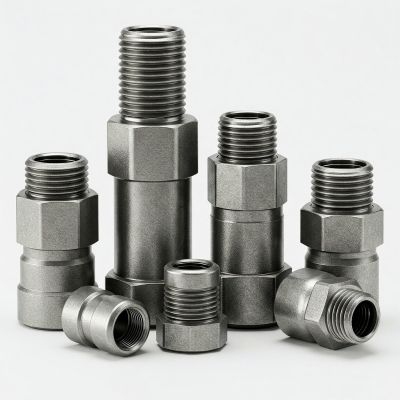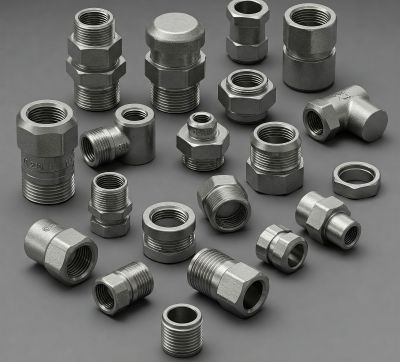Pipe threads play a crucial role in fluid and gas connections, ensuring secure and efficient joins between pipes and fittings. Choosing the right type of thread is essential for leak-free connections, system performance, and safety.
Two of the most commonly used thread types are straight pipe threads and tapered pipe threads. In this blog, we will compare their key differences, advantages, and applications to help you make the best choice for your needs.
What Are Pipe Threads?
Pipe threads are helical structures on the ends of pipes and fittings that enable secure connections. They are essential in plumbing, hydraulics, and various industrial applications, ensuring proper fluid or gas transfer.
Common Pipe Thread Types
➡️ NPT (National Pipe Tapered) – Used in the U.S. for plumbing and industrial applications
➡️ NPTF (National Pipe Taper Fuel) – Provides a tighter seal without the need for thread sealant
➡️ BSPP (British Standard Pipe Parallel) – A straight thread used in Europe and internationally
➡️ BSPT (British Standard Pipe Tapered) – A tapered thread used mainly in Europe
What Are Straight Pipe Threads?
Straight pipe threads have parallel threads with a consistent diameter along their length. Unlike tapered threads, they do not provide a natural seal and require additional sealing components.
How They Function
Straight threads rely on O-rings, gaskets, or sealing washers to prevent leaks. They are often used in applications where repeated assembly and disassembly are needed.
Common Standards and Designations
➡️ BSPP (British Standard Pipe Parallel)
➡️ UN (Unified National)
➡️ SAE (Society of Automotive Engineers)
Advantages of Straight Pipe Threads
➡️ Reusable and easier to install – Can be assembled and disassembled multiple times
➡️ Ideal for mechanical assemblies – Used where a leak-tight connection is not required
➡️ Compatible with sealing components – Ensures a secure connection with proper sealing materials
Common Applications of Straight Pipe Threads
➡️ Hydraulic and pneumatic systems
➡️ Industrial machinery and equipment
➡️ Automotive and aerospace applications
What Are Tapered Pipe Threads?
Tapered pipe threads decrease in diameter along their length, allowing them to form a tighter seal when screwed together.
How They Function
Tapered threads create a metal-to-metal seal as they are tightened, but additional sealant (such as thread tape or liquid sealant) is often used to enhance leak prevention.
Common Standards and Designations
➡️ NPT (National Pipe Tapered)
➡️ BSPT (British Standard Pipe Tapered)
➡️ NPTF (National Pipe Taper Fuel)
Advantages of Tapered Pipe Threads
➡️ Self-sealing – The threads compress together to create a seal
➡️ Ideal for high-pressure applications – Ensures a tight, leak-proof connection
➡️ No additional sealing components required – Though sealant is often recommended
Common Applications of Tapered Pipe Threads
➡️ Plumbing and gas lines
➡️ Oil and gas industries
➡️ High-pressure hydraulic systems
Key Differences Between Straight and Tapered Pipe Threads
|
Feature |
Straight Pipe Threads |
Tapered Pipe Threads |
|
Thread Shape |
Parallel (constant diameter) |
Tapered (decreasing diameter) |
|
Sealing Method |
Requires O-rings, gaskets, or sealing washers |
Forms a seal by thread compression (sealant may be used) |
|
Leak Prevention |
Needs additional sealing components |
Provides a natural leak-tight seal |
|
Best for |
Hydraulic and pneumatic systems, mechanical assemblies |
High-pressure applications, fluid and gas lines |
|
Reusability |
Can be reused with new seals |
Limited reusability due to thread deformation |
Choosing the Right Thread Type for Your Application
Selecting the correct thread type depends on various factors:
➡️ Operating Pressure & Fluid Type – High-pressure systems often benefit from tapered threads
➡️ Reusability Requirements – Straight threads are better for applications requiring frequent disassembly
➡️ Sealing Needs – If a leak-free seal is critical, tapered threads with sealant may be the best option
➡️ Industry Standards Compliance – Ensure the selected thread type meets regulatory requirements
Conclusion
Understanding the differences between straight and tapered pipe threads is essential for selecting the right type for your application. While straight threads offer reusability and flexibility, tapered threads provide a self-sealing, high-pressure solution.
Choosing the correct thread type can improve system performance, prevent leaks, and enhance safety. If you need guidance on selecting the best pipe threads, consult with experts or explore high-quality fittings for optimal results.
Post time: Feb-28-2025



